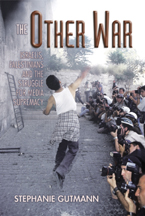|
Reviewed by Randall G. Rogan, Ph.D., Professor of Communication and Department Chair, Wake Forest University A significant dimension of modern-day life is the omnipresence of mass media. From seemingly minor incidents of local weather conditions to major international conflagrations, media serves as the primary conduit of information to the masses. Though the growth of non-traditional media outlets have burgeoned in the last decade, with countless web sites and blogs devoted to just about every topic imaginable, traditional media services continue to be the dominant source of news and information. Contrary to myth and legend, media outlets are not objective conveyers of truth and reality, but rather are active participants in constructing reality by highlighting certain events while ignoring others and thereby engaging in agenda setting, by identifying and explaining the source of potential threats to humankind via cognitive priming, and by offering recommendations, both explicitly and implicitly, for policy solutions designed to address these issues (Norris, Kern, & Just, 2003). Taken together, these activities are more appropriately defined as media/news framing. Briefly, news framing denotes the linguistic interpretive devices that journalists (print and visual) employ to situate individual news events within a broader context of understanding. As noted by Norris, Kern, & Just (2003) “News frames bundle key concepts, stock phrases, and iconic images to reinforce certain common ways of interpreting developments. The essence of framing is selection to prioritize some facts, images, or developments over others, thereby unconsciously promoting one particular interpretation of events. Perhaps in no other context do we witness the consciousframing of news than in media coverage of the Israeli/Palestinian conflict. This is the central thesis of Stephanie Gutmann’s book, The Other War: Israelis, Palestinians, and the Struggle for Media Supremacy, concerning news media coverage of the Second Intifada. The book consists of eleven chapters, but it is the first three chapters that truly grab the reader’s attention. In these chapters, Gutmann provides an historical discussion about various incidents that occurred during the Second Intifada, beginning with an infamous Associated Press photo of a young American student bloodied by a Palestinian mob who was incorrectly identified in the caption as an Arab who was brutally beaten by an Israeli police officer. In reality, the police officer was captured in the image because he was there to help the victim. Using that notoriously misidentified image as a starting point, Gutmann introduces us to the inherent bias in Western media coverage of this conflict and the media’s general reluctance to correct their mistakes in a manner similar to their initial reporting of events. Gutmann continues to highlight the asymmetry of media coverage with case study reviews of the abduction and killing of two Israel Defense Forces (IDF) soldiers in Ramallah in October of 2000 and the Mohammed al-Dura “shooting” a few days earlier. Recent reviews of the al-Dura video footage and court proceedings in France have raised serious questions about the veracity of not just the film footage itself, but more critically, the entire shooting incident and the media’s rush to judgment about the events of that fateful day. The remaining chapters are written in first-person narrative about Gutmann’s excursions to Israel and the Palestinian territories in quest of information and insight into international media coverage of both Israeli and Palestinian activities. Drawing on her own conversations and interviews with media personnel, Gutmann provides ample anecdotal evidence in support of her claim of media bias. She argues that while the Palestinian Authority (PA) has placed significant restraints on the media in what and how it can report events in the Palestinian territories, Western media simply seem to acquiesce to these restrictions and accept the storyline provided by the PA. Yet, by comparison, reporters cynically question any efforts by Israel to limit media coverage and attribute sinister motives to the Israeli perspective. She contends that former PA Chairman Yassar Arafat and the PA implemented a well-honed media apparatus to exploit media coverage of events and to further the Palestinian cause. On the other hand, she shows how Israel was woefully ignorant in its capacity to work with Western media to secure balanced reporting. Although this is not a scholarly piece of research, in the traditional academic sense, this book is a thought-provoking exposé of media framing in general and of the Second Intifada in particular. Without actually couching her thesis within this construct, Gutmann depicts the inherent bias in news framing. As Jasperson and El-Kikhia posit, “Media framing, also known as the second level of agenda setting, is a mechanism of influence in which journalists employ a frame of interpretation in presenting an issue to the public. In other words, media coverage is characterized by an active construction, selection, and structuring of information to organize a particular reality in a meaningful manner for the public.” It is this construction of reality that Gutmann so deftly captures in this book. Gutmann also reminds us of the need to be ever vigilant of media that claim to present the truth, regardless of the motive. |


 The Other War: Israelis, Palestinians, and the Struggle for Media Supremacy
The Other War: Israelis, Palestinians, and the Struggle for Media Supremacy